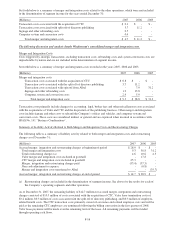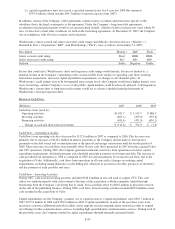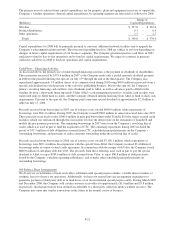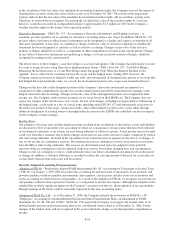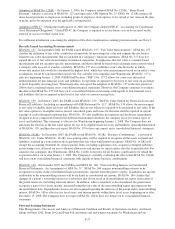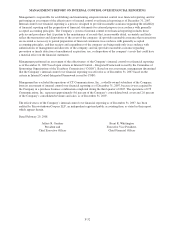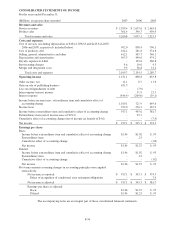Windstream 2007 Annual Report Download - page 112
Download and view the complete annual report
Please find page 112 of the 2007 Windstream annual report below. You can navigate through the pages in the report by either clicking on the pages listed below, or by using the keyword search tool below to find specific information within the annual report.
in the calculation of the fair value of its indefinite-lived wireline franchise rights, the Company assessed the impact of
forgoing these revenues on the fair value of those assets as of November 30, 2007. The results of the impairment
analysis indicate that the fair value of the indefinite-lived wireline franchise rights still exceed their carrying value.
Therefore, no write-down was required. Decreasing the calculated fair value of the franchise rights by 5 percent,
however, would have resulted in an impairment charge of approximately $1.5 million in 2007 on the Company’s
wireline franchise rights in the former Valor operating markets.
Derivative Instruments – SFAS No. 133, “Accounting for Derivative Instruments and Hedging Activities”, as
amended, provides guidance on accounting for derivatives, including interest rate swaps. In addition, SFAS No. 133
governs when a derivative or other financial instrument can be designated as a hedge, and requires recognition of all
derivative instruments at fair value. Accounting for changes in the fair value of derivatives depends on whether the
instrument has been designated as, qualifies as and is effective as a hedge. Changes in fair value of the effective
portions of hedges should be recorded as a component of other comprehensive income in the current period. Changes
in fair values of derivative instruments not qualifying as hedges, or of any ineffective portion of hedges, should be
recognized in earnings in the current period.
The effectiveness of the Company’s cash flow hedges is assessed each quarter. The Company has historically assessed
its swaps as being effective using Derivatives Implementation Group (“DIG”) Issue No. G7, “Cash Flow Hedges:
Measuring the Ineffectiveness of a Cash Flow Hedge under Paragraph 30(b) When the Shortcut Method Is Not
Applied,” due to critical terms matching between the swaps and the hedged items. During 2007, however, the
Company repaid a portion of its hedged variable rate debt, and subsequently de-designated the portion of its swaps that
had hedged this repaid principle value. As a result, the de-designated portion of its swaps were deemed ineffective.
Changes in the fair value of the designated portion of the Company’s derivative instruments are reported as a
component of other comprehensive income (loss) in the current period and will be reclassified into earnings as the
hedged transaction affects earnings. Changes in the fair value of the undesignated portions are recognized in other
income, net. The Company settles interest payments on its swaps based on the LIBOR rate. The Company does not
expect any changes in the effectiveness of its swaps, but any such changes, including any prepayment or refinancing of
the hedged items, could result in a loss of critical terms matching under DIG No. G7 and subsequently an increase in
the ineffective portion of the swaps. An increase in the value of the ineffective portion of its swaps either through
further de-designation of existing swaps or through further decreases in the LIBOR rate could have an adverse impact
on the Company’s future earnings.
Income Taxes
Our estimates of income taxes and the significant items resulting in the recognition of deferred tax assets and liabilities
are disclosed in Note 12 and reflect our assessment of future tax consequences of transactions that have been reflected
in our financial statements or tax returns for each taxing authority in which we operate. Actual income taxes to be paid
could vary from these estimates due to future changes in income tax law or the outcome of audits completed by federal
and state taxing authorities. Included in the calculation of our annual income tax expense are the effects of changes, if
any, to our income tax contingency reserves. We maintain income tax contingency reserves for potential assessments
from the IRS or other taxing authorities. The reserves are determined based upon our judgment of the probable
outcome of the tax contingencies and are adjusted, from time to time, based upon changing facts and circumstances.
Changes to the tax contingency reserves could materially affect our future consolidated operating results in the period
of change. In addition, a valuation allowance is recorded to reduce the carrying amount of deferred tax assets unless it
is more likely than not that such assets will be realized.
Recently Adopted Accounting Pronouncements
Adoption of FIN 48 – Windstream adopted FASB Interpretation No. 48 “Accounting for Uncertainty in Income Taxes”
(“FIN 48”) on January 1, 2007. FIN 48 clarifies the accounting for and disclosure of uncertainty in tax positions and
provides guidance on the recognition, measurement, derecognition, classification, and disclosure of tax positions and
on the accounting for related interest and penalties. As a result of the adoption of FIN 48, we recognize accrued interest
and penalties related to unrecognized tax benefits as a component of income tax expense. Although the adoption of this
standard has not had a significant impact on the Company’s tax provision thus far, the recognition of tax uncertainties
through earnings in the future could be materially impacted by this new accounting policy.
Adoption of SFAS No. 158 – As of December 31, 2006, the Company adopted the provisions of SFAS No. 158
“Employers’ Accounting for Defined Benefit Pension and Other Postretirement Plans, an amendment of FASB
Statements No. 87, 88, 106 and 132(R)”. SFAS No. 158 required the Company to recognize the funded status of its
defined benefit pension and postretirement plans in its consolidated balance sheet as of December 31, 2006. Future
changes in the funded status will be recognized in the year in which the change occurs through other comprehensive
income.
F-26


